Reality Show Pastor Killed by Snakebite
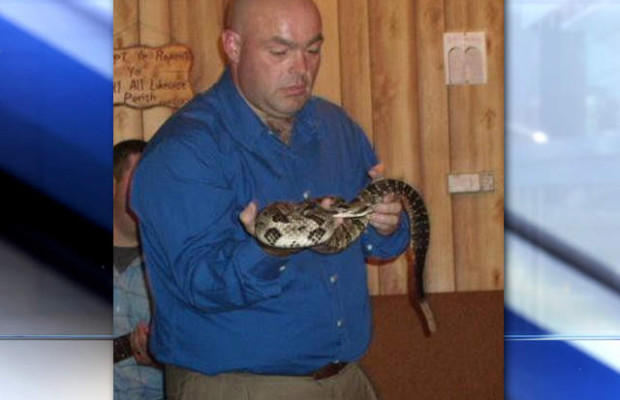
Jamie Coots, a serpent-handling pastor who is featured on the National Geographic’s reality show Snake Salvation, was killed during a service when he was bitten by a rattlesnake. The 42-yr0ld  pastor of the Full Gospel Tabernacle in Jesus Name in Middlesboro, KY was bitten by a 4 foot long timber rattlesnake (right). Coots refused medical care and died 2 hours later.
pastor of the Full Gospel Tabernacle in Jesus Name in Middlesboro, KY was bitten by a 4 foot long timber rattlesnake (right). Coots refused medical care and died 2 hours later.
Coots practiced the so-called “signs of the gospel” found in Mark 16, which included taking up serpents. If bitten, believers often refuse medical care saying God would heal them. If they died, that would be God’s will. Handling serpents in worship is illegal in most states. Many states also prohibit the possession of venomous serpents (including rattlesnakes).
Coots’ son Cody said his father was handling 3 rattlesnakes near the pulpit, when one bit him on the base of his thumb. He quickly became sick and went to the bathroom to vomit, telling Cody “My face feels like it’s on fire.” He quickly became unconscious, and it took 5 men to carry him to a car to take him home. He never regained consciousness and family members refused to allow Coots to be taken to the hospital, with Cody saying:
“He always said, Don’t take me to the doctor'” if he was bitten. “It was totally against his religion.”
Coots first attracted attention in 1990’s when he and friend John Wayne “Punkin” Brown were featured in the book Salvation on Sand Mountain: Snake Handling and Redemption in Southern Appalachia. Brown died of a snakebite in 1998.
He was arrested in 2008, when Kentucky police found dozens of poisonous snakes in his home. He was later able to get permits to own the snakes.
Last fall, Coots and Pastor Andrew Hamblin of Tabernacle Church of God in LaFollette, TN became the stars of the National Geographic reality show Snake Salvation. Coots hoped the show would bring his preaching to a larger audience, telling the Tennesean:
“If one person sees it and it converts them or causes them to go to a church, then it will be worth it.”
Coots will be buried tonight. He leaves behind a wife, two children, a granddaughter and his father.
What do I need to know about venomous snakes?
Venomous snakes found in the United States include rattlesnakes, copperheads, cottonmouths/water moccasins, and coral snakes. It has been estimated that 7,000–8,000 people per year receive venomous bites in the United States, and about 5 of those people die.
Rattlesnakes
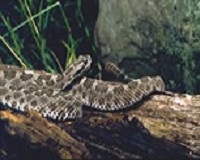
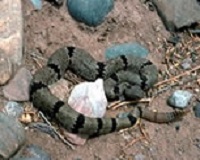
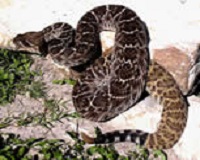
Photos courtesy of U.S. Fish and Wildlife Service (1 & 2) and Edward J. Wozniak (3)
There are many species of rattlesnakes in the United States. Rattlesnakes are the largest of the venomous snakes in the United States. They can accurately strike at up to one-third their body length. Rattlesnakes use their rattles or tails as a warning when they feel threatened. Rattlesnakes may be found sunning themselves near logs, boulders, or open areas. These snakes may be found in most work habitats including the mountains, prairies, deserts, and beaches.
U.S. Geographic Region: Across the United States.
Copperheads
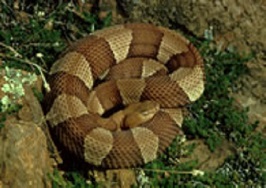
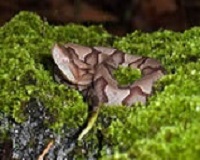
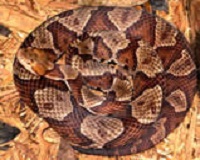
Photos courtesy of U.S. Fish and Wildlife Service (1 & 2) and Edward J. Wozniak of CDC (3)
Copperheads vary in color from reddish to golden tan. The colored bands on their body are typically hourglass-shaped. Most adults are 18–36 inches long. They are not usually aggressive, but will often freeze when frightened. Workers are more likely to be bitten when they unknowingly step on or near a copperhead. Copperheads are often found in forests, rocky areas, swamps, or near sources of water like rivers.
U.S. Geographic Region: Eastern states, extending as far west as Texas.
Cottonmouths/Water Moccasins
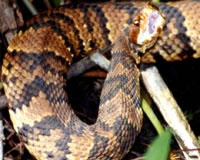
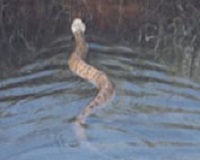
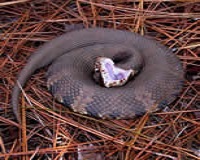
Photos courtesy of U.S. Fish and Wildlife Service (1 & 2) and Edward J. Wozniak (3)
Cottonmouth snakes average 50–55 inches long. The adult snake’s skin is dark tan, brown, or nearly black, with vague black or dark brown crossbands. Juveniles have a bold crossbanded pattern of brown or orange with a yellow tail. Cottonmouths are frequently found in or around water. They do not scare easily and will defend themselves when threatened.
U.S. Geographic Region: Wetland areas, rivers, lakes, etc., in the southeastern states.
Coral Snakes
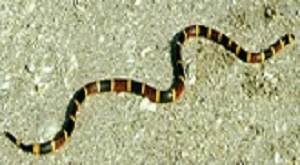
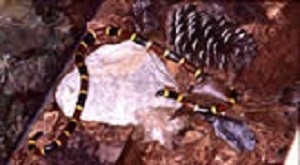
Photos courtesy of U.S. Fish and Wildlife Service (1) and Edward J. Wozniak (2)
These snakes are often confused with nonvenomous king snakes, which have similar colored bands although in a different arrangement. However, if the red bands are touching the yellow bands, then it is a venomous coral snake. Coral snakes tend to hide in leaf piles or burrow into the ground.
What are the symptoms of snake bite?
 Depending on the type of snake, the signs and symptoms may include:
Depending on the type of snake, the signs and symptoms may include:
- A pair of puncture marks at the wound
- Redness and swelling around the bite
- Severe pain at the site of the bite
- Nausea and vomiting
- Labored breathing (in extreme cases, breathing may stop altogether)
- Disturbed vision
- Increased salivation and sweating
- Numbness or tingling around your face and/or limbs
What To DO if You or Someone Else is Bitten by a Snake
- If you or someone you know are bitten, try to see and remember the color and shape of the snake, which can help with treatment of the snake bite.
- Keep the bitten person still and calm. This can slow down the spread of venom if the snake is poisonous.
- Seek medical attention as soon as possible.
- Dial 911 or call local Emergency Medical Services (EMS).
- Apply first aid if you cannot get the person to the hospital right away.
- Lay or sit the person down with the bite below the level of the heart.
- Tell him/her to stay calm and still.
- Cover the bite with a clean, dry dressing.
What NOT To Do if You or Someone Else is Bitten by a Snake
- Do not pick up the snake or try to trap it (this may put you or someone else at risk for a bite).
- Do not apply a tourniquet
- Do not slash the wound with a knife.
- Do not suck out the venom.
- Do not apply ice or immerse the wound in water.
- Do not drink alcohol as a pain killer.
- Do not drink caffeinated beverages.
Source: Centers for Disease Control



























0 comments